Twelve years investment in reading and applying the Cognitive Science principles behind retrieval practice and the “testing effect,” led to a further 12 months of development into RememberMore with my students. 2 lock downs and 12 month road-testing later with RememberMore – we have refined and twinned that routine.
Unmistakably Kate Jones’s work @KateJones_teach, Retrieve ➡️ Reflect ➡️ Reorder ➡️ Repeat is a great place to start from.
- Set the Retrieval (the content or substantive knowledge).*
- Give learners the opportunity to Reflect, time to think hard is important (“effortful practice” is proposed theoretical explanation for the benefits of retrieval practice). As a teacher this can then be followed by corrections or opportunities to explore interrogative elaborations (how and why).
- With the smallest possible change to the practice, to Reorder the “same set prompts.”
- And then Repeat.
What to set, where you are in the learning cycle matters.*
It makes sense. Simple routined, retrieval practice, with the simplest adaptation to promote success, important for a number of sound pedagogical reasons. Time to reflect or “effortful practice” important. Reordered and “revisiting learning” underpinned by much of Rawson’s research. Correctly recalling items one time in three sessions versus three times in one session yielded a 262% increase in retention test performance (d 2.17), (Rawson et al., 2018). Repeated exposure, a sound move towards ‘Successive Relearning,’ (SR)*.
Combining these two methods under the conditions in which they are most effective yields a promising learning technique referred to as successive relearning.
Rawson et al., (2013).
With Dobson (2013) stating that
Retrieval practice alone can provide improved recall performance by as much as 10-20%. When combined with Spaced Retrieval (Successive Relearning), the effect is multiplied.
(Dobson, 2013).
The move towards SR, where educators or learners give sincere consideration to the spacing of retrieval practice (moving toward interleaved retrieval) and the success rates achieved by learners is integral to RememberMore. Leveraging not only the direct benefits of retrieval, but corrective feedback and elaborative interrogation opportunities, and the indirect benefits gained from metacognitive and self-regulatory awareness and learner confidence accrued from success as a result of successive relearning.
Classroom (CRM), RememberMore (RM) and Dashboard (DRM) makes it even easy to access these “substantial” “unequivocal” reported gains – see Agarwal et al., (2021) and Yang et al., (2021).
What if?
Moving towards RRRR and SR with RememberMore follows an all to familiar pattern.
What if you could facilitate retrieval practice or SR approach approach (and more) in less than ten seconds?
Ten seconds? – Really? Come on?
[Confidently] Yes. And more. Quite a bit more if I am honest.
Ten seconds? To set a retrieval practice… set time to reflect, with options to reorder and repeat (and more) – in less than ten seconds, mimicking Kate’s RRRR approach.
Yes. Set and select a retrieval practice, from thousands of categorised and tagged retrieval prompt pairs. The actual retrieval learning and re-learning activity clearly takes longer than that. With a Reorder option at a click.
Then I would be impressed. Show me.
Demo Classroom: A demo shows how fast, flexible and easy it is to set the retrieval practice (our content, your content, or a mixture of both.) Invariably we discuss the various additional options, but let’s hold off for a moment. With the retrieval practice displayed via the Classroom platform, the Reorder option is available, so is Reveal, (show prompt-pair either one at a time or reveal all).
Then there is more. There is Refresh. (call for new retrieval practice prompts from the previously selected tags, resetting the timer, without leaving the display.) There is also a quick ‘Print‘ option – retrieval practice for a quick cover option. Finally, the option to go back and Refine the tags.

At the set up page – you can explore the additional flexibility: Number of prompts, the four modes, show/hide tags (making retrieval considerably harder) and countdown timer.
At this point – I will leave you to explore. It is all open, instantly accessible and free.
How to set up Classroom (CRM)
Four simple steps in less than ten seconds. Retrieve ➡️ Reflect ➡️ Reveal ➡️ Repeat With options to Reorder, Refresh and Refine the tags.
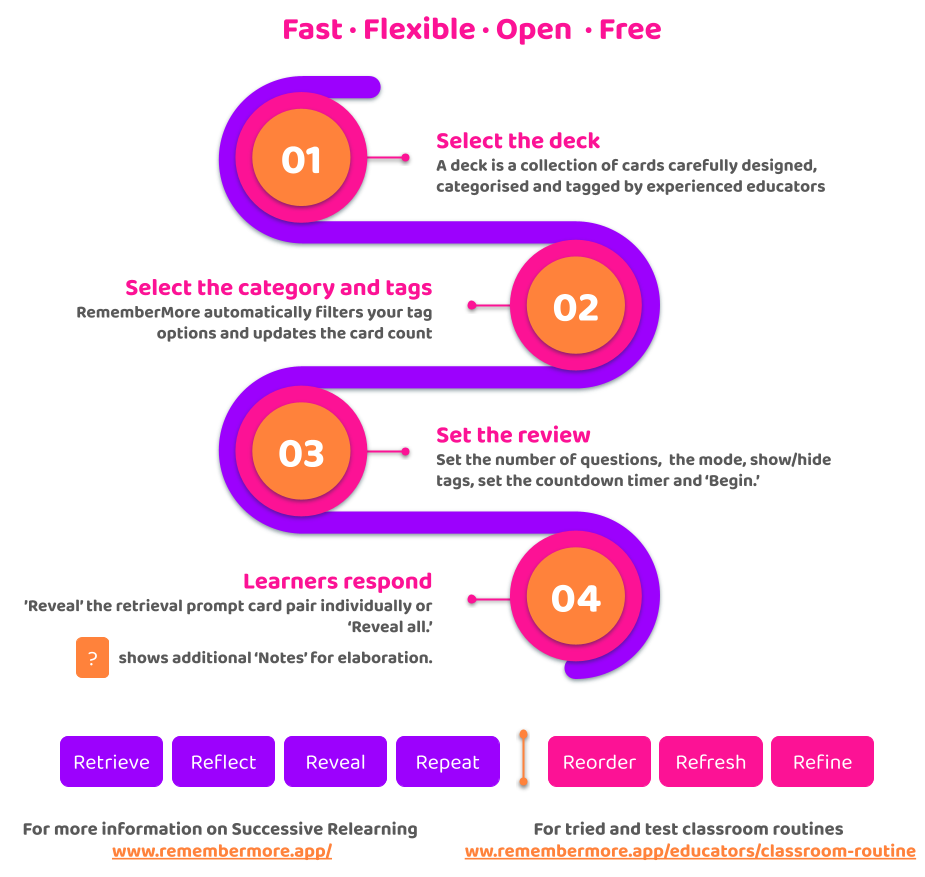
- Select a deck: Here I have selected KS3 Eng Romeo and Juliet.
- Select the categories and tags: the scenes from Act 1 #RJ 1.1, #RJ 1.2, #RJ 1.3, #RJ 1.4, #RJ 1.5. #Love and Marriage.
- Set the review / retrieval parameters. 5 prompts from 390 road-tested cards. Match Mode. Show tags. 2 minutes countdown. Keep the total cards below 30. Question 3-6 works well.
- Learners respond.
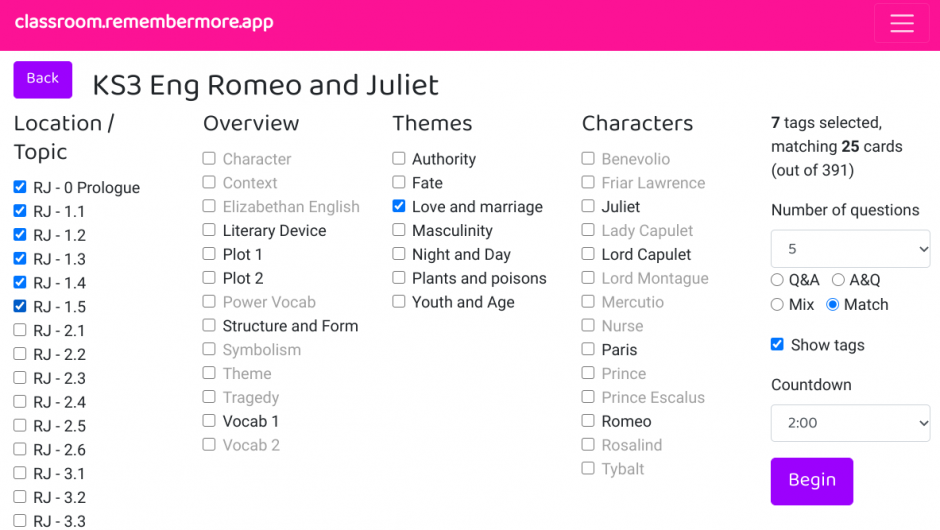
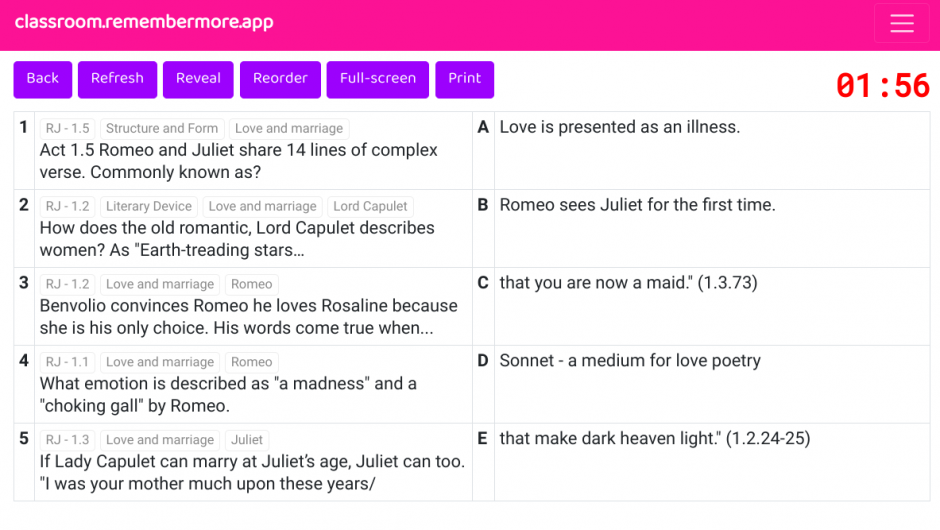
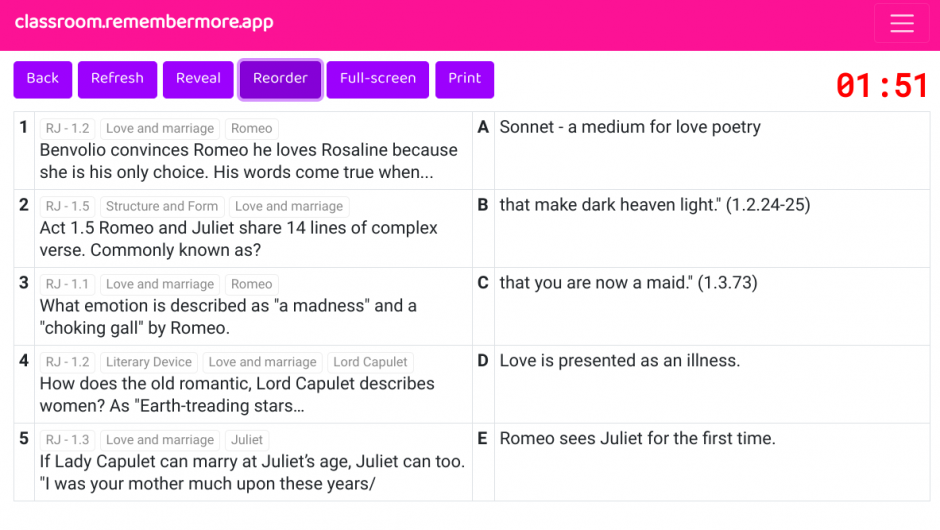
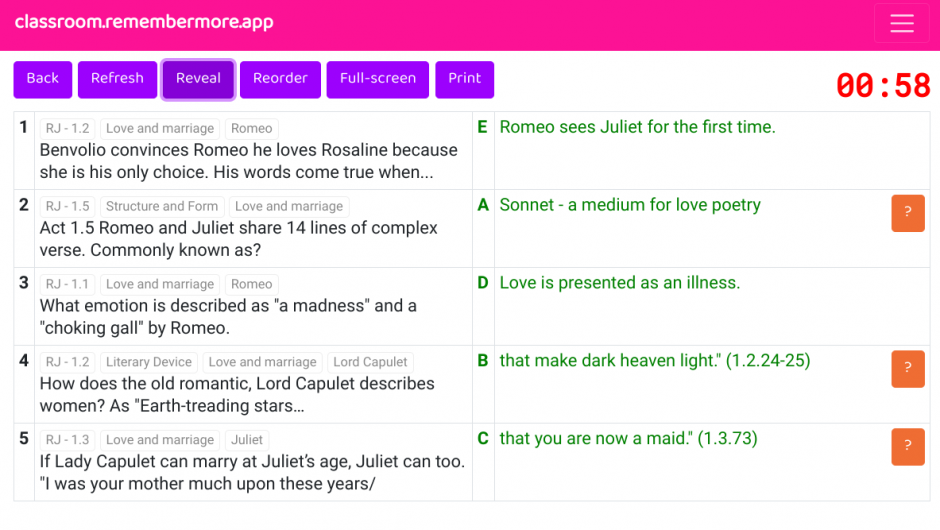
Given that your students are returning to your classrooms from uniquely different learning experiences, you can focus in on what you want learners to remember (or prepare them to learn something new). You can set or target the plot line, or track a theme, or select a particular scene or character… Or even a particular scene AND character from a particular scene? Say Act 3 Scene 5 AND Juliet.
You can make it a little easier, or little more challenging, by varying the number of questions, time and the decision to show/hide tags. Now with Reorder and Refresh options and a back button to Refine the tags (RRRR-RRR).
We will leave a full explanation of the use of elaboration (orange button ‘?’) or not… for another day. For now – the notes section or ‘?’ offers educators the option to elaborate, prompt or share additional content. For example, adding Cold War references to Animal Farm, or Victorian historical context to A Christmas Carol or Oliver Twist.
Printed off 15 RM questions today from CRM, kids attached into books… so quick and easy to do and MASSIVE TIME SAVER.
Feedback from today from the field – re Reorder. The very small / subtle change created using “Reorder” was well received.
One of my more difficult boys in Year 11 ‘likes these quizzes’. Notably engagement is also way up.
Classroom.remembermore.app – Open and fast. Flexible and Free with access to thousands of prompts and the change to add your own, or build your own platform? See https://classroom.remembermore.app/demoschool.
RememberMore
Finally – Testing is well under way with the RememberMore app delivering an adaptive Successive Relearning experience for learners. Try Capital Cities for free to get a feel for the app – iOS and Android. Delivering either our content, your content, or both. Let me know if this is something you want to explore?
The routine for the app includes a confidence based assessment or Report following the Reveal.
Retrieve ➡️ Reflect. ➡️ Reveal ➡️ Report ➡️ Repeat. With options to Reorder ➡️ Refresh ➡️ Refine.
More importantly, based on the learner report and use, RememberMore applies an adaptive algorithm to optimise learning and provide a Challenge level to inform the setting of the Review.
Update 10.03.21: The RememberMore app (4.01) released to iOS and Android app stores.
A great tool to aid revision for my A Level DT course. Quick and easy to use, the app allows me to do little bits of revision each day so it doesn’t become overwhelming.
EMA784, 16/03/2021
More information available at Remembermore.app and for educators here.
Dashboard update coming soon…
Update 07.04.21: Development on the Dashboard falls into two broad categories. It is either important “managing CRM and RM” or very exciting “metric and insights.” Already, this information is being used by educators to inform their teaching and support learners.
| Managing CRM and RM | Metrics and Insights |
| Manage the brand – logo and colours. Admin Users Decks | Presenting live metrics Presents: Last active, Cards seen, Cards memorised, Time invested A visualisation of Deck, Cards seen and cards memorised. |
Successive Relearning* – During initial learning, engaging in retrieval practice with restudy until all items have been learned to criterion (With RememberMore that is three consecutive i.e., correctly recalled responses.) Then, in one or more subsequent sessions, students engage in additional retrieval practice with restudy until all items are successfully relearned (i.e., correctly recalled from memory and in with RememberMore that is a confirming “I know it” responses.)
24.04.21 Update
One of the key benefits of working on RememberMore on two fronts, as developer and practitioner, is that the hands on delivery experience is just so insightful. Below are the key points of what I learnt, introducing CRM (improved) with RM.
Retrieve ➡️ Reflect ➡️ Reveal ➡️ Report ➡️ Repeat. With options to Reorder ➡️ Refresh ➡️ Refine. The Reorder button is so powerful in building early success. Reorder and Refresh, together, are very effective combination..
- Introducing RememberMore. Learners in all three classes had accessed the relevant decks ahead of the class, roughly 20%.
- In Year 7 30% do not have a mobile device, in Year 8 this is reduced to 20%.
- By Wednesday, learners were asking to start the lesson with RememberMore.
- Class is very quite. I teach with CRM to those students without RM.
- Some access the app at home, all have access to CRM,
- This term I share one Year 8 class with a teacher in training. She is very comfortable with both CRM and RM.
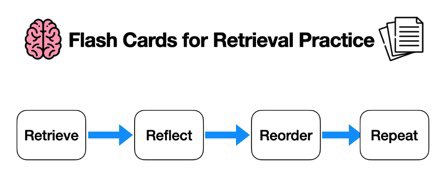


Pingback: Opening with RememberMore | KristianStill
Pingback: Vocabulary: What does it look like (part 5) | KristianStill